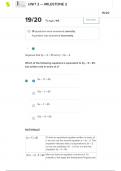UNIT 2 — MILESTONE 2
19/20
19/20 that's 95% RETAKE
19 questions were answered correctly.
1 question was answered incorrectly.
1
Suppose that 3y – 5 = 45 and y = 3x – 2.
Which of the following equations is equivalent to 3y – 5 = 45,
but written only in terms of x?
9x – 11 = 45
15x – 1 = 45
9x – 1 = 45
15x – 11 = 45
RATIONALE
To find an equivalent equation written in terms of
x we can use the second equation y = 3x – 2. This
equation indicates that y is equivalent to 3x – 2
so we can substitute 3x – 2 in for y in the first
equation 3y – 5 = 45.
Now we have an equation in terms of x. To
simplify it, first apply the Distributive Property and
, multiply 3 by the terms in the parentheses.
UNIT 2 — MILESTONE 2
3 times 3x equals 9x, and 3 times -2 equals -6.
Next, combine -6 and -5 together.
-6 and -5 together is -11. This equation is 19/20
equivalent to the original equation, but is written
in terms of x.
CONCEPT
Substitution in Multi-Step Linear Equations
Report an issue with this question
2
For the arithmetic sequence beginning with the terms {-2, 0, 2,
4, 6, 8...}, what is the sum of the first 18 terms?
238
304
340
270
RATIONALE
To find the sum of the first 18 terms in this
sequence, we first need to find the 18th term.
To find the value of any nth term, use the
formula , where is the
value of the first term, is the value of the
nth term, d is the common difference, and n is
the number of terms. There are two variables
, we can substitute right away: the value of the
UNIT 2 — MILESTONE 2
first term and the number of terms.
We see that the first term, , is -2 and we
want to find the sum of 18 terms, so n is 18. 19/20
Next, we can find the common difference,
which is the difference between each term in
the sequence.
We can see that each term increases by
from one to the next, so plug in for d. To find
the value of the 18th term, evaluate the
parentheses.
18 minus 1 is 17. Next, multiply 2 by 17.
2 times 17 is 34. Then, add -2 and 34.
The 18th term is equal to 32. Now that we
know the value of the 18th term, we can use
the formula for finding the sum.
In the formula , is the
value of the first term, is the value of the
nth term, and n is the number of terms. We
know that , , and n = 18.
Once these values are plugged into the sum
formula, we can start by evaluating the
parentheses.
-2 plus 32 is 30. Next, divide 18 by 2.
18 divided by 2 is 9. Finally, multiply this value
by 30.
9 times 30 is 270. The sum of the first 18 terms
of this sequence is 270.
CONCEPT
Finding the Sum of an Arithmetic Sequence
Report an issue with this question
3




